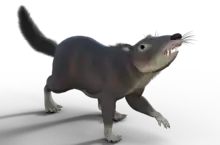Volaticotherium
Volaticotherium antiquum (meaning "ancient gliding beast") is an extinct, gliding, insectivorous mammal that lived in what would become Asia during the Jurassic period, around 164 mya. It is the only member of the genus Volaticotherium.
| Volaticotherium | |
|---|---|
 | |
| Holotype, Paleozoological Museum of China | |
| Scientific classification | |
| Kingdom: | Animalia |
| Phylum: | Chordata |
| Class: | Mammalia |
| Order: | †Eutriconodonta |
| Clade: | †Volaticotherini |
| Genus: | †Volaticotherium Meng et al., 2006 |
| Type species | |
| †Volaticotherium antiquum Meng et al., 2006[1] | |
The discovery of Volaticotherium provided the earliest-known record of a gliding mammal (70 million years older than the next oldest example),[2] until the discovery of the contemporary haramiyidans Maiopatagium, Vilevolodon and Xianshou, and provided further evidence of mammalian diversity during the Mesozoic Era. The closely related and significantly older Argentoconodon shows similar post-cranial adaptations for aerial locomotion also seen in Volaticotherium.[3]
Discovery
The only known fossil of Volaticotherium was recovered from the Daohugou Beds of Ningcheng County, Inner Mongolia, China. The age of the Daohugou Beds is currently uncertain and the subject of debate, but most studies suggest an age of around 164 plus or minus 4 million years ago.[4] The description was published in an issue of the journal Nature.[1]
Description

Volaticotherium had a gliding membrane, sometimes compared to modern-day flying squirrel, that extended not just between the limbs and at least the tail base, but also the digits, "sandwiching" them. It was densely covered by fur.[5] The tail was flat, increasing the airfoil, and the limbs were proportionally long, comparable to those of modern flying and gliding mammals. The toes were grasping, as typical for arboreal mammals; the hand, however, was poorly preserved and its anatomy is therefore unclear.[5] The teeth of Volaticotherium were highly unusual, possessing long, curved, backwards-pointing cusps, possibly used for shearing; this, combined with the long canines, this indicates a carnivorous diet, which at its small size was probably composed of insects. This is supported by a study ranking it among insectivorous taxa, while the related Argentoconodon ranked in carnivorous taxa.[6] It has been noted that most gliding mammals are predominantly herbivorous,[7][8] which would make volaticothere carnivory truly exceptional. In particular, Volaticotherium itself has been compared to insectivorous bats, and its femur has unique adaptations among mammals that make it resistant to flight stresses, and render terrestrial locomotion cumbersome.[9]
Classification
The phylogenetic analysis conducted by the authors of the description of Volaticotherium antiquum recovered it as the sister taxon of the clade that contained, among other taxa, eutriconodonts, multituberculates, spalacotheriid and tinodontid "symmetrodontans", dryolestids, metatherians (including marsupials) and eutherians (including placental mammals). As the analysis did not place Volaticotherium within any of the previously known main groups of Mesozoic mammals, the authors of its description erected a separate family Volaticotheriidae and order Volaticotheria for it.[1] However, Zhe-Xi Luo (2007) mentioned that Volaticotherium might actually be a eutriconodont.[10] This was eventually confirmed by the phylogenetic analyses conducted by Leandro C. Gaetano and Guillermo W. Rougier (2011, 2012); these analyses recovered Volaticotherium antiquum as a eutriconodont that belonged to the family Triconodontidae and subfamily Alticonodontinae, and was particularly closely related to the genera Argentoconodon and Ichthyoconodon,[3][11] and possibly Triconolestes.[12] More recent studies keep this relationship, but move Volaticotherium, Argentoconodon, Ichthyoconodon and Jugulator (and, possibly by association, Triconolestes) in a more basal position among triconodontids, away from alticonodontines.[13]
References
- Meng, J., Hu, Y., Wang, Y., Wang, X., Li, C. (Dec 2006). "A Mesozoic gliding mammal from northeastern China". Nature. 444 (7121): 889–893. Bibcode:2006Natur.444..889M. doi:10.1038/nature05234. PMID 17167478.CS1 maint: multiple names: authors list (link)
- Smithsonian Magazine (2007). "Wild Things: Life As We Know It". Smithsonian Magazine. Retrieved 2008-02-22.
- Leandro C. Gaetano and Guillermo W. Rougier (2011). "New materials of Argentoconodon fariasorum (Mammaliaformes, Triconodontidae) from the Jurassic of Argentina and its bearing on triconodont phylogeny". Journal of Vertebrate Paleontology. 31 (4): 829–843. doi:10.1080/02724634.2011.589877.CS1 maint: uses authors parameter (link)
- Gao, K. -Q.; Shubin, N. H. (2012). "Late Jurassic salamandroid from western Liaoning, China". Proceedings of the National Academy of Sciences. 109 (15): 5767–72. Bibcode:2012PNAS..109.5767G. doi:10.1073/pnas.1009828109. PMC 3326464. PMID 22411790.
- Meng, J.; Hu, Y.-M.; Wang, Y.-Q.; Wang, X.-L.; Li, C.-K. (2007). "Corrigendum: A Mesozoic gliding mammal from northeastern China". Nature 446 (7131): 102. Bibcode:2007Natur.446Q.102M. doi:10.1038/nature05639.
- David M. Grossnickle, P. David Polly, Mammal disparity decreases during the Cretaceous angiosperm radiation, Published 2 October 2013. doi:10.1098/rspb.2013.2110
- Jackson, Stephen Matthew and Schouten, Peter. Gliding Mammals of the World, Csiro Publishing, 2012
- Zhe-Xi Luo; Qing-Jin Meng; David M. Grossnickle; Di Liu; April I. Neander; Yu-Guang Zhang; Qiang Ji (2017). “New evidence for mammaliaform ear evolution and feeding adaptation in a Jurassic ecosystem”. Nature. in press. doi:10.1038/nature23483.
- Meng, J.; Hu, Y.; Wang, Y.; Wang, X.; Li, C. (2006). "A Mesozoic gliding mammal from northeastern China". Nature. 444 (7121): 889–893. Bibcode:2006Natur.444..889M. doi:10.1038/nature05234. PMID 17167478.
- Zhe-Xi Luo (2007). "Transformation and diversification in early mammal evolution". Nature. 450 (7172): 1011–1019. Bibcode:2007Natur.450.1011L. doi:10.1038/nature06277. PMID 18075580.
- Leandro C. Gaetano and Guillermo W. Rougier (2012). "First Amphilestid from South America: A Molariform from the Jurassic Cañadón Asfalto Formation, Patagonia, Argentina". Journal of Mammalian Evolution. 19 (4): 235–248. doi:10.1007/s10914-012-9194-1.CS1 maint: uses authors parameter (link)
- A. O. Averianov and A. V. Lopatin. 2011. Phylogeny of Triconodonts and Symmetrodonts and the Origin of Extant Mammals. Doklady Biological Sciences 436:32-35 [M. Uhen/M. Uhen]
- Thomas Martin, Jesús Marugán-Lobón, Romain Vullo, Hugo Martín-Abad, Zhe-Xi Luo & Angela D. Buscalioni (2015). A Cretaceous eutriconodont and integument evolution in early mammals. Nature 526, 380–384. doi:10.1038/nature14905
- Meng, J.; Hu, Y.-M.; Wang, Y.-Q.; Wang, X.-L.; Li, C.-K. (2007). "Corrigendum: A Mesozoic gliding mammal from northeastern China". Nature. 446 (7131): 102. Bibcode:2007Natur.446Q.102M. doi:10.1038/nature05639.





